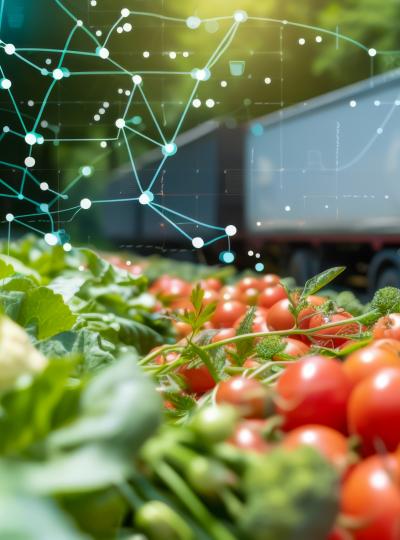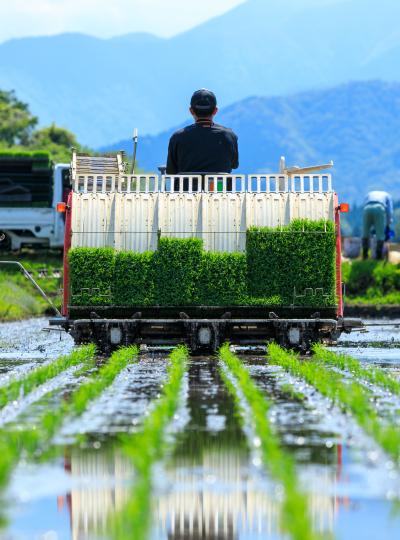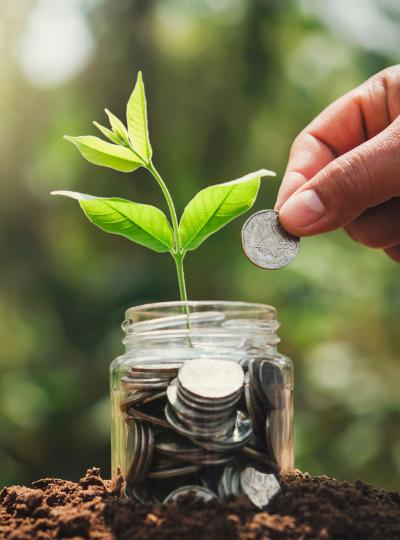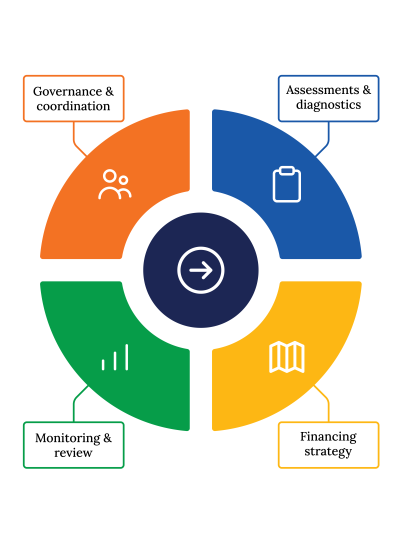Agritech and Precision Agriculture







Business Model Description
Implement precision farming techniques using sensors, data analytics, and automated systems to optimize resource use (water, fertilizers, pesticides) and increase crop yields for smallholder farmers. This includes providing comprehensive training and technical support to ensure effective adoption of these technologies.
Expected Impact
Integrating advanced technologies can significantly enhance productivity, reduce waste, and improve resource management.
How is this information gathered?
Investment opportunities with potential to contribute to sustainable development are based on country-level SDG Investor Maps.
Disclaimer
UNDP, the Private Finance for the SDGs, and their affiliates (collectively “UNDP”) do not seek or solicit investment for programmes, projects, or opportunities described on this site (collectively “Programmes”) or any other Programmes, and nothing on this page should constitute a solicitation for investment. The actors listed on this site are not partners of UNDP, and their inclusion should not be construed as an endorsement or recommendation by UNDP for any relationship or investment.
The descriptions on this page are provided for informational purposes only. Only companies and enterprises that appear under the case study tab have been validated and vetted through UNDP programmes such as the Growth Stage Impact Ventures (GSIV), Business Call to Action (BCtA), or through other UN agencies. Even then, under no circumstances should their appearance on this website be construed as an endorsement for any relationship or investment. UNDP assumes no liability for investment losses directly or indirectly resulting from recommendations made, implied, or inferred by its research. Likewise, UNDP assumes no claim to investment gains directly or indirectly resulting from trading profits, investment management, or advisory fees obtained by following investment recommendations made, implied, or inferred by its research.
Investment involves risk, and all investments should be made with the supervision of a professional investment manager or advisor. The materials on the website are not an offer to sell or a solicitation of an offer to buy any investment, security, or commodity, nor shall any security be offered or sold to any person, in any jurisdiction in which such offer would be unlawful under the securities laws of such jurisdiction.
Country & Regions
Sector Classification
Food and Beverage
Jamaica faces a $800 million food import bill and 30% post-harvest losses due to inefficiencies in agro-processing, storage, and supply chains. Only 30% of raw materials for food processing are sourced locally, exacerbating reliance on imports and food insecurity. Malnutrition, obesity, and diet-related diseases are rising, reflecting systemic gaps in equitable food access and quality
Policy Priority
Aligned with Vision 2030 and the National Food and Nutrition Security Policy, Jamaica prioritizes agro-processing to enhance food security, reduce imports, and promote high-value exports.
Investment Opportunity Area
Food and agriculture have long been cornerstones of Jamaica's economy. As the nation strives to achieve the Sustainable Development Goals (SDGs) and realize the ambitious goals outlined in Vision 2030, there is a growing imperative to transform its agricultural sector into a sustainable, resilient, and high-value industry.
Gender Inequalities and Marginalization Issues
Women constitute ~60% of small-scale farmers but face limited access to credit, land, and technology. Rural youth and marginalized communities are disproportionately affected by climate vulnerabilities and poor market linkages.
Key Bottlenecks
Infrastructure gaps: Limited cold storage, processing plants, and energy-efficient technologies hinder scalability
Food and Agriculture
Development Need
Jamaica faces persistent food insecurity, with one-third of respondents reporting going a full day without eating in May 2023. The country relies on imports for 74% of food trade, making it vulnerable to global price fluctuations. Climate shocks like Hurricane Beryl (2024) caused $67 million in damages, exacerbating agricultural decline and food access issues
Policy Priority
The National Food and Nutrition Security Policy emphasizes reducing dependence on imports by promoting local production and agro-processing. Vision 2030 prioritizes sustainable farming, climate-smart practices, and value-added agriculture to boost food security, economic resilience, and export competitiveness.
Key Bottlenecks
Supply chain inefficiencies, Climate risks disrupt raw material supply chains
Agricultural Products
Pipeline Opportunity
Agritech and Precision Agriculture
Implement precision farming techniques using sensors, data analytics, and automated systems to optimize resource use (water, fertilizers, pesticides) and increase crop yields for smallholder farmers. This includes providing comprehensive training and technical support to ensure effective adoption of these technologies.
Business Case
Market Size and Environment
USD 100 million - USD 1 billion
15% - 20%
Number of agritech-enabled farms – agritech solutions (IoT, AI, drones) are adopted.
As agriculture is a significant part of Jamaica’s economy, Agricultural Technology solutions, which include smart farming and automation, could help modernize the industry.
Jamaica's tropical climate and diverse topography are conducive to a variety of crops, presenting opportunities for agritech solutions tailored to local conditions.
The Jamaican government recognizes agriculture and technology as key drivers for economic growth, aiming to revitalize the economy by leveraging advancements in these sectors.
Indicative Return
> 25%
The Ministry of Agriculture, Fisheries and Mining is collaborating with private-sector companies to integrate more technology into farming practices, particularly targeting small farms. (https://www.moa.gov.jm/content/ministry-pursuing-further-partnerships-integrate-more-technology-agriculture)
The Development Bank of Jamaica (DBJ) supports agriculture, agro-processing, and agritech through debt, grant, and equity financing. Over the past decade, the DBJ has facilitated 14,358 loans valued at over $9.7 billion to entrepreneurs and businesses in the agriculture sector, underscoring the sector's profitability. (https://dbankjm.com/elementor-9986/)
The adoption of innovative techniques like hydroponics farming is being promoted in Jamaica to boost local production and reduce food import dependency. (https://farmonaut.com/usa/revolutionizing-jamaican-agriculture-innovations-and-strategies-for-self-sufficiency-and-productivity)
Investment Timeframe
Medium Term (5–10 years)
Studies indicate that precision agriculture technologies can lead to input cost savings between 20% and 30%, with payback periods ranging from 2 to 6.75 years. Investments can become profitable within a medium-term period, making a 5-10 year. (https://www.challenge.org/knowledgeitems/the-real-return-of-investment-roi-on-precision-agriculture/)
Jamaica's Vision 2030 is a comprehensive plan aiming to position the country as "the place of choice to live, work, raise families and do business" by 2030. Emphasizes the adoption of advanced technologies and sustainable practices, which are expected to yield significant returns over a 5-10 year period.
Jamaica’s prime location in the Caribbean, with easy access to major North and South American markets. The island is strategically positioned as a logistics and trade hub. With the continued enhancement of logistics networks, agritech investments in Jamaica are poised to benefit from an efficient distribution system.
Ticket Size
USD 1 million - USD 10 million
Market Risks & Scale Obstacles
Capital - CapEx Intensive
Market - Volatile
Impact Case
Sustainable Development Need
Agritech and Precision Agriculture in Jamaica tackle critical social and environmental challenges, including climate change impacts, food insecurity, and rural economic vulnerability
Vulnerable to climate change, experiencing increased droughts, hurricanes, and soil erosion. Between 1994 and 2010, climate-related events caused losses of J$14.4 billion in the agriculture sector. These events disrupt food production, reduce yields, and threaten rural livelihoods, particularly for small-scale farmers who comprise 85% of agricultural holdings.
Dependence on food imports, making it vulnerable to global supply chain disruptions. Local production struggles due to low productivity, outdated farming techniques, and limited access to modern technologies. This threatens food security for the nation’s 3 million residents.
Gender & Marginalisation
Women and marginalized groups in rural areas often face limited access to resources and opportunities in the agricultural sector. Agritech can empower these groups by providing access to technology, training, and markets.
Expected Development Outcome
Increased agricultural productivity, reduced reliance on food imports, improved food security, enhanced resilience to climate change, and reduced environmental impact.
Climate-smart agriculture initiatives, such as those implemented under the Ja REEACH project, have trained over 1,000 farmers in practices like water diversion ditches, agroforestry, and reforestation. These efforts protect watersheds and enhance resilience to extreme weather events. (https://www.worldagroforestry.org/news/climate-smart-agriculture-jamaica)
Precision agriculture tools such as drones for crop monitoring and soil sensors for efficient fertilizer use are being piloted in Jamaic.a’s farming communities. These technologies have demonstrated up to a 30% increase in yields on demonstration farms
Gender & Marginalisation
Increased participation of women and marginalized groups in the agricultural sector, improved access to resources and opportunities, and enhanced livelihoods.
Equitable Access to Land and Resources: The IOA tackles gender biases in land acquisition by prioritizing women’s access to agricultural lands through gender-responsive policies.
Economic Empowerment Through Capacity Building: Agritech interventions focus on training women farmers in climate-smart practices such as aquaponics and precision irrigation, enabling them to diversify income streams.
Primary SDGs addressed

2.1.1 Prevalence of undernourishment
2.3.2 Average income of small-scale food producers, by sex and indigenous status
2.4.1 Proportion of agricultural area under productive and sustainable agriculture
SDG 2.1.1: Prevalence of Undernourishment. Approximately 6.2% of the population in Latin America and the Caribbean faces undernourishment, with Jamaica reflecting similar trends due to food import dependency and climate-related agricultural challenges. Localized data is limited, but initiatives under Vision 2030 aim to reduce hunger by increasing domestic food production and resilience.
SDG 2.3.2: Income of Small-Scale Food Producers Current Level: Small-scale farmers in Jamaica earn significantly less than large-scale producers, with women and youth disproportionately affected. Limited access to financing, technology, and markets exacerbates this gap.
SDG 2.4.1: Agricultural Sustainability Current Level: Less than 30% of Jamaica’s agricultural land employs sustainable practices, with soil degradation and water scarcity being major concerns.
SDG 2.1.1: Prevalence of Undernourishment -Reduce the prevalence of undernourishment to below 3% by 2030, aligning with Vision 2030 Jamaica’s goal to achieve food security through increased domestic production and reduced reliance on imports. This will be supported by investments in agritech solutions like precision farming and climate-resilient crops.
SDG 2.3.2: Income of Small-Scale Food Producers - Increase the average income of small-scale farmers by at least 50% by 2030, with a focus on women and youth. This will be achieved through enhanced access to financing, modern technologies, and market linkages under agribusiness initiatives such as greenhouse farming clusters.
SDG 2.4.1: Proportion of Agricultural Area Under Sustainable Practices - Ensure that at least 50% of agricultural land employs sustainable practices by 2030, up from the current estimate of less than 30%.

12.3.1 (a) Food loss index and (b) food waste index
SDG 12.3.1: Global Food Losses Current Level: Post-harvest losses in Jamaica for crops like yams and bananas are estimated at 15–20%.
SDG 12.3.1: Global Food Losses- Halve post-harvest losses to less than 10% by 2030 through expanded cold storage facilities, improved logistics, and blockchain-enabled supply chain management systems

13.2.1 Number of countries with nationally determined contributions, long-term strategies, national adaptation plans, strategies as reported in adaptation communications and national communications
SDG 13.2.1: Climate Action Plans Current Level: Jamaica has integrated climate-smart agriculture into its national policies under Vision 2030, with projects like the Southern Plains Agricultural Development Project addressing climate risks. However, implementation gaps remain due to limited funding and technical capacity
SDG 13.2.1: Climate Action Plans - Fully integrate climate-smart agriculture into national policies by 2030, ensuring that all major farming regions adopt resilient practices to mitigate climate risks like droughts and hurricanes
Secondary SDGs addressed




Directly impacted stakeholders
People
Gender inequality and/or marginalization
Planet
Public sector
Indirectly impacted stakeholders
People
Corporates
Public sector
Outcome Risks
Technological Disparities The adoption of precision agriculture technologies might widen the gap between large-scale and small-scale farmers if access to these technologies is not equitably distributed. This could further marginalize small-scale farmers, particularly women, who may lack the resources to adopt new technologies
Environmental Risks Pollution of soil, water, and air due to increased use of chemicals and machinery.
Economic Risks Outcome: High transaction costs and perceived risks in lending to farmers might deter financial institutions from providing necessary capital. This could limit the adoption of modern technologies, hindering productivity gains and economic growth in the sector
Impact Risks
This can widen economic disparities between large-scale and small-scale producers, potentially exacerbating poverty and social inequality in rural areas
This can lead to biodiversity loss, soil erosion, and water contamination, exacerbating environmental degradation and threatening long-term agricultural sustainability
Impact Classification
What
Improved agricultural productivity and sustainability through technology adoption (e.g., drones, precision irrigation) enhance food security and reduce environmental degradation
Who
Small-scale farmers, women farmers, and rural communities benefit from increased access to modern technologies and market opportunities, improving livelihoods and economic empowerment
Risk
Climate-related shocks, pest infestations, and economic volatility pose significant risks to agricultural stability and sustainability, affecting both farmers and the environment
How Much
Increase agricultural output significantly by 2030, with a focus on reducing reliance on imports by at least 30% and enhancing domestic food production to meet 70% of consumption needs
Impact Thesis
Integrating advanced technologies can significantly enhance productivity, reduce waste, and improve resource management.
Enabling Environment
Policy Environment
Vision 2030 Jamaica: Aligns agritech with national development goals, focusing on sustainable agriculture and food security
Medium-Term Framework (MTF): Guides the implementation of Vision 2030, emphasizing agritech adoption to achieve national development goals
National Food & Nutrition Security Policy: Emphasizes the role of high-quality planting material in improving productivity
Financial Environment
Tax Incentives under Productive Input Relief (PIR): Reduces costs for importing agritech equipment like drones and irrigation systems
Development Bank of Jamaica (DBJ) Loans: Offers concessional loans for agritech investments, supporting small farmers with up to $30 million in financing
Southern Plains Agricultural Development (SPAD) Project: Administered by the Agro Investment Corporation (AIC), this project provides matching grants of up to 80% to small farmers for essential resources.
Regulatory Environment
Agricultural Produce Act: This Act governs the export of agricultural produce, ensuring quality standards and compliance. It includes regulations for vegetables, fruits, and ground provisions, which are essential for maintaining export competitiveness and supporting agritech-driven productivity improvements
Jamaica Agricultural Commodities Regulatory Authority (JACRA) Act: This Act establishes JACRA, which regulates and promotes the development of agricultural commodities like coffee, cocoa, coconut, and spices. It focuses on setting quality standards, providing certification, and facilitating market access for farmers
Marketplace Participants
Government
The Ministry of Agriculture plays a vital role in policy development and support through entities like the Rural Agricultural Development Authority (RADA) which promotes drone technology adoption among farmers. Bodles Research Station: A government-run research institution conducting research and development in agriculture.
Private Sector
PreeLabs Limited is a technology company that focuses on developing and implementing automation and remote monitoring solutions and products primarily utilizing the Internet-of-Things. Grace Kennedy Foods: a conglomerate with vertical integration into agricultural operations.
Multilaterals
Food and Agriculture Organization, United Nations Development Programme, European Union, United States Agency for International Development, Interamerican Development Bank, Caribbean Development Bank.
Private Sector
Development Bank of Jamaica (BIGEE Programme, Innovation Grant), MSCALE VC Fund. First Angel Investor Network.
Target Locations
References
- (1. RADA Drone Initiative: Utilizes drones with multispectral cameras 2. Jamaica 4-H Clubs: Pilots precision agriculture systems through the "Grow Smart, Eat Smart" 3. Langston University Collaboration: Partners with RADA 4. Plentiful Harvest Farms – A Hydroponic Farm Investment in Jamaica















